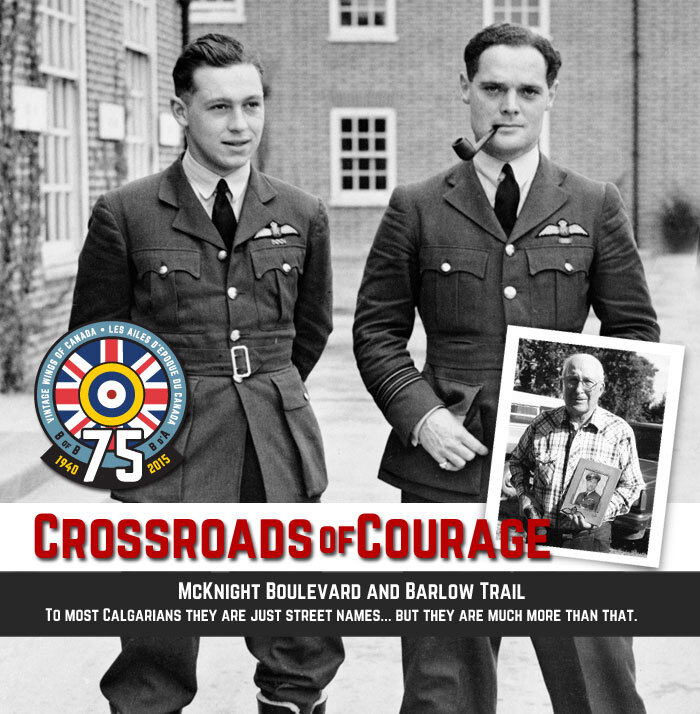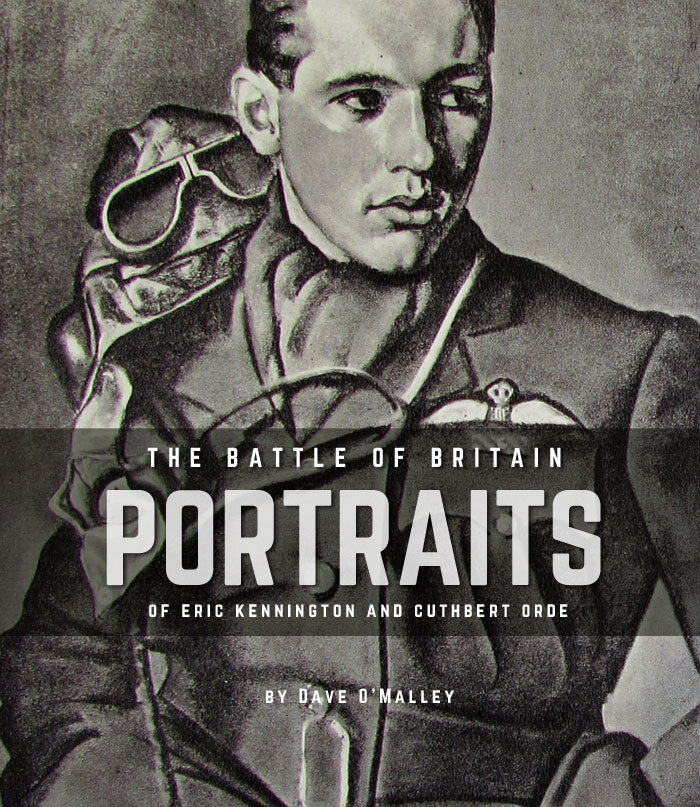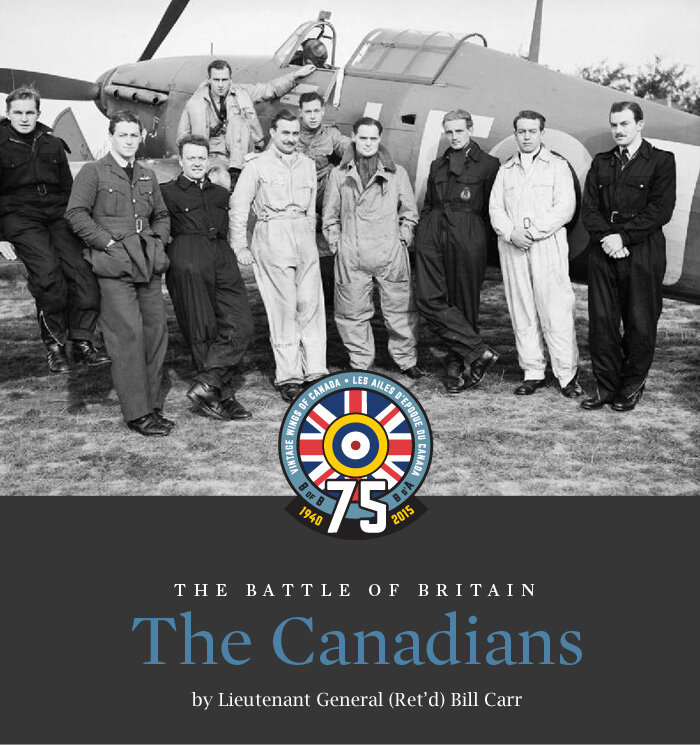The Return of the Reaper
April 25, 2022
On January 12, 1941, Canadian triple-ace Flying Officer William Lidstone McKnight, DFC took off from RAF Martlesham Heath just after noon, in the company of fellow 242 Squadron pilots Hugh Tamblyn of North Battleford, Saskatchewan, Bruce Rogers of Bootle, Lancashire and Marvin Brown of Kincardine, Ontario. They flew out over the Suffolk coast and south towards France on a “Mosquito Patrol” (later called a “Rhubarb”) — a search for suitable military targets at low altitude.
Timothy Dubé, arguably the leading authority on the life and military career of McKnight, tells us what happened next:
“After about twenty-five minutes, the two pairs split up. McKnight and Brown delivered sea-level attacks on an E-boat in the Channel near the Dyck Lightship, before turning inland over France at the old fortress town of Gravelines – midway between Calais and Dunkirk – descending practically to ground level to ‘pepper hell’ out of a concentration of German troops seen entrenched close to the beach. Fired upon from anti-aircraft emplacements on the ground – flak and machine-gun, whose fire was both substantial and extremely accurate – they were then bounced by Me.109s. McKnight and Brown became separated. Brown made it home that day; McKnight – piloting Hurricane P2961 – did not.”
It is not known whether he was hit by flak or was shot down by the attacking German fighter, but it is most likely that he crashed into the sea. The 22-year old pre-medical student from Alberta is remembered on Panel 30 of the Runnymede Memorial — dedicated to airmen who have know known grave.
More than 81 years later, another Canadian by the name of Michael Potter, having brought together the resources, the determination and a passion for historical accuracy watched as his dream to honour McKnight’s legacy took flight. At 0900 hrs on Saturday, April 23, 2022 a Hawker Hurricane Mk XII, painted in the unique and bold markings of McKnight’s Hurricane Mk I took to the air after a 16-year restoration by Vintech Aero, Potter’s maintenance organization.
In 2006, Mike Potter purchased the Canadian Car and Foundry-built Hawker Hurricane Mk XII from Assiniboia, Saskatchewan farmer, pilot and AME Harry Whereatt. Whereatt was a legend in the early years of historic aircraft recovery and restoration in Canada, having purchased relic fuselages, wings and engines for, among other types, Canadian-built Lysanders and Hurricanes and stored them on his South Saskatchewan farm. The Hurricane XII (RCAF Serial Number 5447 C/N 46002) was a project that Harry had been working on for decades and had been flown by him on at least a couple of occasions, so was sold as an aircraft on flying condition.
After its arrival at the Vintage Wings facility in Gatineau, Québec, the Hurricane was stripped of it skin for inspection and its wings were sent to a Southern Ontario shop for some work on fuel tanks. In order to ensure a solid paperwork trail, It was decided to take the aircraft down and start over, including an all-new wing centre section which required the building of a massive jig to guarantee alignment. Early work on the project included some supervised time put in by volunteers, keeping the project moving along slowly.
Unlike the all-metal Spitfire, the Hurricane’s structure includes some wood components in the fuselage, requiring not only skills in metal-working but also cabinet making. A considerable portion of that was the excellent work of Harry Whereatt.
Early on, it was decided to paint the restored Hurricane in the unique and very distinctive markings of a Hurricane I (Serial No. P2961) flown by Willie McKnight a Canadian pilot in the RAF. The squadron nose art included a cheeky depiction of Hitler being booted in the ass by a black flying boot with 242 written on it. But more strikingly, the side of the fuselage carried a large representation of a skeletal grim reaper with a sickle in hand pointing forward to the enemy he is about to claim. It is widely held that McKnight, a former pre-med student at the University of Alberta, was the artist who did the design.
Work on the restoration took many years as the Vintech team focused on other projects such as the Roseland Spitfire . After the completion of the Spit, Vintech returned to the Hurricane project with gusto, and the aircraft was ready for the paint booth. Considerable research and effort was expended getting the aircraft’s paint colours and markings right. In doing so we were able to show that all previous guesses by modellers and artists as to the size of the roundel and fin flashes were incorrect.
Once painted, engine tests and high-speed taxi tests proceeded in 2021 but its first flight was postponed until after this past winter.
The First Flight
Waiting for winter to pass had one great benefit — the Hurricane’s iconic 242 Squadron nose art of Hitler getting the boot and McKnight’s even more dramatic grim reaper pilot art were hand painted on the sides while winter ran its course. This would make the aircraft’s markings even more authentic for her first flight.
As soon all the necessary people were in place in Ottawa and the weather was warm enough and clear enough to take her into the sky for her first flight, Dave Hadfield, Vintage Wings’ Chief Pilot flew down from Barrie, Ontario to do the test flight. Early Saturday morning, Vintech engineers prepared the Hurricane for her maiden flight. Restoration project lead Pat Tenger and Director of Maintenance Paul Tremblay fussed over last minute details, knowing their years of work were about to be put to the test. Engineer Laurent Palmer tweaked the radios and avionics and André Laviolette helped with the myriad of work needed before the engine start. Vintage Wings photographer Peter Handley and videographer Jacques Ménard arrived early in the morning to record events.
Dave Hadfield, with test flight advice from John Aitken, would fly the simple first flight test program and Mike Potter would fly the Extra 330LT chase aircraft with Pat Tenger in the front seat to get still photographs. Vintage Wings pilot Peter Ashwood-Smith rigged a 360˚ camera on the starboard wing tip of the Extra and Dave Hadfield wore a helmet cam.
The weather was overcast and cool, but the wind was steady down the runway and it was time.
Vintech Aero engineers Paul Tremblay (Director of Maintenance)and Pat Tenger (in cockpit) go over last minute details before the flight. Photo: Peter Handley
Vintech AME André Laviolette dons his LE-A sneakers in preparation for the first flight of the Hurricane that inspired the design. The shoes are made by I Love a Hangar and were suggested to the manufacturer by Timothy Dubé, the leading authority on McKnight’s life and flying career. Photo: Peter Handley
Hadfield briefed the tower before the flight so that they were aware of the activity and the potential for a problem. Then he and Mike Potter briefed the formation work they would do aloft and the goals for the test flight. The entire syllabus would be executed with the wheels down an the airspeed below 140 miles per hour indicated. Cycling the gear would be for another day.
Still in the hangar, Dave Hadfield goes over his checklists. Photo: Peter Handley
Hadfield executes a pre-flight walk around and tests the “ring” of the exhaust stacks which might reveal an otherwise invisible crack. Photo: Peter Handley
Related Stories
Click on image
Mike Potter (Right) and Hadfield confer before the Hurricane is pushed from the hangar. Potter, the founder of Vintage Wings of Canada Foundation and Vintech Aero, will fly the Extra 330LT chase aircraft. Photo: Peter Handley
Early Saturday, April 23, 2022 Paul Tremblay pushed the Hurricane into the weak April sunlight. Photo: Peter Handley
Dave Hadfield checks rudder movement Paul Tremblay briefs City of Gatineau firefighters . Photo: Peter Handley
Time to strap in. Photo: Peter Handley
The Grim Reaper artwork point forward to the work to be done — in this case to test the Hurricane in flight — One take-off, a short, slow-speed flight including a couple of stalls and one landing — all with the wheels down. Photo: Peter Handley
With everything in order, Hadfield climbed into the cockpit and strapped in. The engine start went well with “three partial shots of prime… plus one stroke of the wobble pump to build pressure. No missing or coughing after start” according to Hadfield’s text notes. “The brakes worked well,” he continued, “and taxi visibility is exceptional for a fighter when the seat is full up.”
Vintech engineer André “Lav” Laviolette gets a pointing lesson from the Grim Reaper himself. Photo: Peter handley
Time to turn the prop. Photo: Peter Handley
Mike Potter in the Extra 330LT is ready to roll with AME Pat Tenger in the front. They will take photos and watch for any visible problems like leaks and smoke. Photo: Peter Handley
The winds are light and down the runway as Hadfield taxies to the main ramp at Gatineau where he will do his final run-ups. Photo: Peter Handley
Peter Handley captures the Hurricane in perfect symmetry, as Hadfield runs up the Merlin. Photo: Peter Handley
Dave follows Mike Potter and Pat Tenger in the Extra 330 chase aircraft out to the single Gatineau runway. Photo via Hadfield’s helmet cam.
The long awaited moment is just seconds away as Hadfield turns the Hurricane to line up on Gatineau’s Runway 09. Photo via Hadfield’s helmet cam.
After Potter and Tenger had taken off in the chase aircraft, and Hadfield had lined up on Runway 09, he pushed the throttle up and the prop bit the cool spring air as he released the brakes. In seconds, the ghost of Willie McKnight was airborne and climbing to the airspace block granted to Hadfield by ATC — 2,500 to 5,000 ASL. The entire flight would now be conducted close to the airfield for safety reasons. The flight consisted of a series of wide circuits near the field and two quickly recovered stalls at altitude which came at 85 mph indicated with the gear down and 65 with both the gear and flaps down. According the Hadfield’s notes, the “Ailerons were very well rigged. Hands-off at 130 mph with gear down. Pitch trim covered the desired range. Rudder trim was set at ¾ Right before take-off and not adjusted afterwards. Control forces and response rates were normal. Aircraft feels comfortable on final at 100 mph, with full flaps. Speed reduction happens quickly when power is reduced.” On landing, Hadfield noted that “Aircraft tracks straight. No brakes were used until the speed was quite low: 20 mph or so. Stopping before Taxiway A was easily achieved. Wind was 070/5 on Runway 09. Aircraft was reluctant to make the right turn onto the taxiway. Right brake and power had to be used more aggressively than expected. This tailwheel design has a pronounced centre-detent.”
What follows are photos by Tenger in the chase aircraft, helmet cam screen captures from Hadfield inside the cockpit and surface photography from Handley. Enjoy the flight.
Lift-off. Hadfield climbs into the cool morning air and back into history. The wheels will remain down throughout the flight which will be short and flown at low speed. Cycling the gear will start with the next flight . Photo: Peter Handley
A 242 Squadron Hurricane flies in Canada for the first time. Photo: Peter Handley
Climbing out. Photo: Peter Handley
Meanwhile, inside the cockpit. The Hurricane MK XII (RCAF Serial 5447) takes to the air for the first time in more than 20 years and turns to the test area north of the airfield. Previous owner of the airframe, Harry Whereatt, took the Hurricane (then registered as C-GCAJ) into the skies only a couple of times in 2000 following his restoration. Prior to those flights, the Hurricane had not flown since the Second World War. It is interesting to note the blanking effect of the exhaust glare shield in this photo. No doubt this was fairly effective in reducing the blinding effect from exhaust flares at night. Of course, this Hurricane will never see a night take-off again. Photo via Hadfield’s helmet cam.
Hadfield circles the airfield and flies overhead with Potter off his left wing. Photo: Peter Handley
As Mike Potter slides in close to “The Reaper”, Pat Tenger gets this moody shot of the Willie McKnight Hurricane and shows off the deeply researched and authentic markings of one of the best known fighter aircraft of the Battle of Britain and Blitz defensive aerial battles. Photo: Bundesarchiv
Potter steadies on the Hurricane’s port wing while Tenger grabs a nice shot showing off its beautiful paint scheme Photo: Pat Tenger
Climbing a higher, Hadfield turns to starboard and we get a glimpse of the underside markings — Black “night” underside the port wing and a “robin’s egg blue-like” colour under the starboard wing and fuselage. Photo: Pat Tenger
In line astern with the Hurricane, Tenger gets a god shot of the Hurricane in a light that seems almost without colour. Photo: Pat Tenger
With Potter closing up on the Hurricane, Tenger finds a unique angle on the hurricane. Photo: Pat Tenger
Hadfield completes a stall recovery. In the upper left of the front windshield (just above Kettle Island) stands the Canada Aviation and Space Museum where another Hurricane Hurricane XII is displayed. Photo via Hadfield’s helmet cam.
With the Laurentian Hills on the horizon to the north, Hadfield levels out heading east. Photo: Pat Tenger
A easy turn to the left shows of the beautiful underside colour of the McKnight hurricane which is a different shade than the“Sky” hue used on the fuselage band and nose spinner. Photo: Pat Tenger
Hadfield continues his easy turn. Photo: Pat Tenger
With Potter sliding to the starboard side of the Hurricane, Tenger gets a nice tight short of the pilot art on that side— while intimidating, not nearly so iconic as McKnight’s more famous port side artwork. Photo: Pat Tenger
Now flying northwest over outer suburbs of Outaouais Region with the winding course of the Ottawa River from right to left. Photo: Pat Tenger
Potter drops down in the turn to get a good look at the underside of the Hurricane and its early-war Fighter Command camouflage. Photo: Pat Tenger
Turning final. Photo: Pat Tenger
Coming home . Photo: Pat Tenger
Dave in over the fence on final and about to touch down on Runway 09. Photo via Hadfield’s helmet cam.
Hadfield rolls out after touchdown . Photo: Peter Handley
Hadfield offers up a triumphant thumbs up to Vintage Wings photographers as he taxies back to the hangar. Photo via Hadfield’s helmet cam.
Swinging onto the taxiway, you can read the smile on Hadfield’s face — it was a perfect flight! Photo: Peter Handley
A close-up of that smile! Photo: Pat Tenger
Dave Hadfield goes over some highlights of the flight and aircraft handling with Vintech Aero engineers. Photo: Peter Handley
Bravo Zulu Dave, Mike and Pat. Photo: Peter Handley
Dave Hadfield and Mike Potter shake hands over the successful first flight. Now, it’s on to Oshkosh! Photo: Peter Handley
The core team that worked on the Hurricane project: Jim Luffman, Volunteer; Laurent Palmer, Vintech Aero; Paul Tremblay, Director of Maintenance, Vintech Aero; Pat Tenger, Restoration Project Lead, Vintech Aero; Dave Hadfield, pilot; Mike Potter, Founder and Funder; John Aitken, test program consultant; André Laviolette, Vintech Aero. Of course, over the 16-year span of the Vintech restoration, there were many others who worked on the project. Three notable contributors who were not present for the first flight are Korrey Foisey who did an extraordinary job of the paint scheme, Mike Irvin who did magic with the fabric and Ken Wood who worked on fabrication of some of the more difficult sheet metal components as well as other work. Photo: Peter Handley


















































